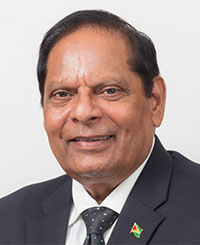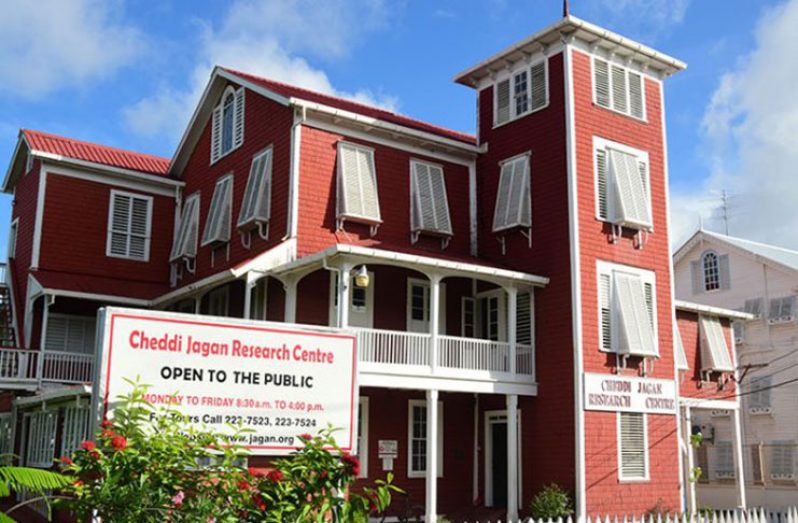By Moses V. Nagamootoo, Prime Minister & First Vice President
I have read the rash reactions to the re-possession by the State of Red House and the

erroneous impression being conveyed that our administration has thrown out “Jagan’s papers”.
The action by the State is now the subject of litigation, and I ought not to comment on the merits of the case. However, I wish to reflect briefly on the character of the Cheddi Jagan that I knew and how this controversy could impact on his image.
In 1961 when I joined the Victory Motorcade in Crabwood Creek, I barely caught a glimpse of Cheddi Jagan, as our lorry was way behind the procession of vehicles. But, like everyone else in the procession, I embraced him as the people’s hero and did so, until his death in 1997.
Over the many years of my association with “Comrade Cheddi” I found him to be frugal in the use of public resources and disinterested in personal material acquisitions.
He had lived at rented premises and state buildings for almost 20 years before he built his

own, modest house. He didn’t take state land though he could have done so as a former Premier. He bought a piece of Ramkarran’s land and started to build his house in 1965, mostly by self-help. I was there as part of the voluntary brigade from Berbice to do land-fill in what was then a swampy area in Bel Air Village. Today, the Bel Air house is a Heritage Building and could be used, if the beneficiaries so wish, as the President Cheddi Jagan Library.
GENTLE PERSUASION
Though Dr. Jagan was always dapper and exquisitely dressed, he clung to the clothes he had worn over many years. I used every gentle persuasion I could have mustered in 1978 to get him to buy a new safari jacket in Hungary whilst we were en route to Africa. With me at his side, the Guyanese leader navigated almost a dozen state stores in Budapest before he settled on an acceptable, low-priced outfit.
This was a leader who insisted on the proper use of the public purse and restricted what might appear to be excesses in the discharge of public functions. Upon assumption of office as President, he immediately abolished excessive pomp and ceremony such as what I had described as the “Timehri Pantomime” that required Ministers and Diplomats to travel to the airport every time the President left the country.
He scoffed at the idea of being conferred with the nation’s highest award on the basis of what was dubbed “the Nagamootoo principle” of not accepting honours from the State whilst holding Cabinet portfolio. Whilst he lived, he would never erect or have erected in his name a statue or bust, in his likeness.
LEAN AND CLEAN ATTRIBUTES
I could go on and cite numerous other examples that testified to Cheddi Jagan’s “lean and clean” attributes. But suffice to say that that was why he did not readily accept the idea of a Cheddi Jagan Research Centre when I presented to him, during 1993, a proposal from my high school friend, Errol Arthur, whom I had met in Maryland.
I had discussed the concept during separate meetings with Dr. Odeen Ishmael and Dr. David Dabydeen, but it was never floated in the lifetime of Dr. Jagan. I handed the proposal to Mrs. Janet Jagan, and didn’t pursue it any further. I was to play no role whatsoever in the setting up of such a Centre or its operations, though I applauded the sterling efforts of all those who did so.
It was sometime after the death of Cheddi Jagan that his works were removed to Red House as a temporary collecting centre. The Trustees had stated their intention to BUILD a permanent edifice to house Jagan’s works. Initially, Michael Khan inventorised most of Dr. Jagan’s publications and later, Dudley Kishoore returned from Canada to serve as curator at the Centre. A prominent businessman who was close to the Government, was handsomely footing the bill for the centre which was officially launched sometime after with a keynote address by Prof. James Millette, a long-time friend of the late President.
NO LEASE
As far as I am aware, the occupation of Kamana Court or Red House was not effected by any Presidential Order or Cabinet decision. No lease was secured for the use of the building. Neither Jagdeo nor Ramotar, whilst they were Presidents, issued any lease for Red House. That didn’t speak well for these two Jaganite pretenders. They would know that the processes by which they ascended to presidential office would put Cheddi Jagan to shame.
It was after I resigned from the PPP and Government that an iron-clad PPP outfit, styled the Cheddi Jagan Research Centre Inc., extracted from the then Commissioner of Lands a 99-year lease for the expansive plots of land on which the Red House stands. The land rent was fixed at G$1,000 or US$5 per month.
Red House which houses the Cheddi Jagan Rearch Centre was NOT included in the lease and it cannot properly be the subject of the present litigation. “Red House” is a heritage building. It could not be appropriated by a private company without the consent of the National Trust.
It is clear that the possession of a state asset in the name of Jagan’s legacy, in the manner that it was done, is nothing more than a mockery of all the lofty ideals for which that great leader stood. The Red House Heist was tainted with the obsession by the Pradoville Gang to seize state lands or to own same at less than basement price. It was a daylight theft of public property in the name of the revered Cheddi Jagan.
SENSE OF HISTORY
If I learned one thing about David Granger it is that as an historian, he treasures not only records but the image of our history. It must be that sense of history that led him to rename after our first President, the Convention Centre as the Arthur Chung Conference Centre. A similar consideration would have applied to the renaming of the Ogle airport as the Eugene Correia International Airport.
President Granger almost unilaterally named every office at the Ministry of the Presidency after a river in Guyana and adorned the walls with replica of photos that captured historic moments when Guyana became an independent state. He caused to be posted in the chambers of Cabinet the portraits of all of Guyana’s Presidents. I was impressed by that poignant act of inclusion and respect.
It was therefore an eminently fair proposal by President Granger for a single complex to house the works of all of Guyana’s past and/or late Presidents. The response from the PPP that Cheddi Jagan’s legacy would be contaminated if his works co-exist with those of Burnham, was nothing but trash talk. In spite of their political differences Cheddi Jagan wanted since 1955 to re-unite with Forbes Burnham. He spoke incessantly to the “new beginning”, of “racial and political unity” and about a Government of National Unity.
Jagan saw as integration what Ramotar recklessly deemed “contamination” when he proposed “critical support” for the Burnham government, post 1973 rigged elections. He had defined the positive side of Burnhamism, that was anti-imperialist, and wanted to embrace it as progressive. He braved internal party dissent when he initiated talks with Burnham, then President, to form a united government just before Burnham died, and Hoyte killed the initiative.
PRESIDENTIAL LIBRARY
That political backdrop should have been the context in which the post-Jagan PPP ought to accept the proposal of an all-inclusive Presidential Library. But no. It was arrogantly rejected and the proposal was rubbished to excite crude ethnic division and deepen political polarisation. Even the scaremongers would know that there is no fear that Cheddi Jagan could be forgotten. Our first international airport and the state’s dental institution are named after him.
It is now up to the beneficiaries of the estate of Cheddi Jagan to preserve the image and legacy of this great freedom fighter by accepting the concept of a Presidential Library; and perhaps, down the road, a monument in the Botanical Gardens or somewhere else, to the lasting memory of both Cheddi and Janet Jagan.
The least they should want is to allow Bharat Jagdeo to mount on the shoulders of Cheddi Jagan as a platform for his own racist-opportunistic campaign. The Jagdeo-touch would taint Jagan’s incorruptible political career with the stench of pervasive corruption that had characterized his (Jagdeo’s) reign.





.jpg)








